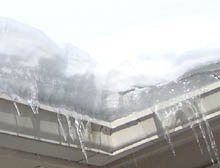With fall closed out, here are some tasks to help prepare for and endure what comes with winter on the interior and exterior of the home.
 Snow Removal
Snow Removal - it usually pays to make preparations for accumulations for snow, depending on
your location. Some situations are best for a snow shovel, others automated equipment, such as a snow blower
or lawn/tractor mounted blade. For more details refer to our
snow removal tips.
Gutters - as a preventative measure, it is great to have gutters
that are secured with pop-out clips, rather than nails or screws. This will make the gutter generally
less likely to bend and deform from stress of a snow load & ice. When the clips are released, if you have these,
after the load has gone the gutters are pressed back in place.
One thing to keep in mind
before having new ones installed!
Roof - to prevent leaking of water due to melting snow, from that
of ice damming, and, based on factors like the home's ventilation system, roof type and structure
(although other factors contribute) - some roofs may be candidates
for
roof warming cables. But installation along with monitor should be
left to the pro's.
Attic - check for adequate type and amounts of insulation to
prevent air loss into the attic space. And that code requirements are met.
- Some homes developing large icicles may signal internal heat loss.
Exterior Trees/Vegetation - be cautious of trees prior to carrying a snow load
combined with potential wind. Spot trees and limbs that might impact the house or other
structures. Delicate trees should have a buildup of snow removed from their limbs to prevent breakage.
Decks & Attached Areas - remove snow buildups for either
the weight or the melting if it might infiltrate behind
the siding/shell of the house - before going into the wall cavity and into the floors.
House wrap barriers typically aren't designed for prolonged exposure to
moisture conditions. Never take unnecessary risks.
Windows/Doors - all air leaks should be adequately sealed prior to the onset of cold temperatures.
See
how to seal exterior doors.
Propane Tanks - check for proper levels of gas and for any backups if needed. If in doubt as to their levels
or for any questions on operation, contact your local authorized dealer. Realizing that it is sometimes easier to replace tanks,
especially larger ones, before much snow or severe temperatures arrive when some dealers become flooded with calls.

 Snow Removal - it usually pays to make preparations for accumulations for snow, depending on
your location. Some situations are best for a snow shovel, others automated equipment, such as a snow blower
or lawn/tractor mounted blade. For more details refer to our snow removal tips.
Snow Removal - it usually pays to make preparations for accumulations for snow, depending on
your location. Some situations are best for a snow shovel, others automated equipment, such as a snow blower
or lawn/tractor mounted blade. For more details refer to our snow removal tips.